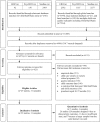Child-Staff Ratios in Early Childhood Education and Care Settings and Child Outcomes: A Systematic Review and Meta-Analysis
- PMID: 28103288
- PMCID: PMC5245988
- DOI: 10.1371/journal.pone.0170256
Child-Staff Ratios in Early Childhood Education and Care Settings and Child Outcomes: A Systematic Review and Meta-Analysis
Abstract
Child-staff ratios are a key quality indicator in early childhood education and care (ECEC) programs. Better ratios are believed to improve child outcomes by increasing opportunities for individual interactions and educational instruction from staff. The purpose of this systematic review, and where possible, meta-analysis, was to evaluate the association between child-staff ratios in preschool ECEC programs and children's outcomes. Searches of Medline, PsycINFO, ERIC, websites of large datasets and reference sections of all retrieved articles were conducted up to July 3, 2015. Cross-sectional or longitudinal studies that evaluated the relationship between child-staff ratios in ECEC classrooms serving preschool aged children and child outcomes were independently identified by two reviewers. Data were independently extracted from included studies by two raters and differences between raters were resolved by consensus. Searches revealed 29 eligible studies (31 samples). Child-staff ratios ranged from 5 to 14.5 preschool-aged children per adult with a mean of 8.65. All 29 studies were included in the systematic review. However, the only meta-analysis that could be conducted was based on three studies that explored associations between ratios and children's receptive language. Results of this meta-analysis were not significant. Results of the qualitative systematic review revealed few significant relationships between child-staff ratios and child outcomes construed broadly. Thus, the available literature reveal few, if any, relationships between child-staff ratios in preschool ECEC programs and children's developmental outcomes. Substantial heterogeneity in the assessment of ratios, outcomes measured, and statistics used to capture associations limited quantitative synthesis. Other methodological limitations of the research integrated in this synthesis are discussed.
Conflict of interest statement
The authors have declared that no competing interests exist.
Figures



References
-
- National Research Council and Institute of Medicine. From neurons to neighborhoods: the science of early childhood development Shonkoff JP, Phillips DA, editors. Washington, DC: National Academies Press; 2000. - PubMed
-
- Ladd G, Herald S, Andrews R. Young children’s peer relations and social competence In: Spodek B, Saracho O, editors. Handbook of research on the education of young children [Internet]. 2nd ed. Mahwah, NJ: Lawrence Erlbaum Associates Publishers; 2006. p. 23–54. Available from: http://www.jstor.org/stable/j.ctt32bq3q
-
- Seifert K. Cognitive development and the education of young children In: Spodek B, Saracho O, editors. Handbook of Research on The Education of Young Children [Internet]. Mahwah, NY, US: Lawrence Erlbaum Associates; 2006. p. 9–22. Available from: http://home.cc.umanitoba.ca/~seifert/cogchapweb.html
-
- Laughlin L. Who’s minding the kids? Child care arrangements: spring 2011 Household economic studies. [Internet]. United States: United States Census Bureau; 2013. p. 1–23. Available from: http://www.census.gov/prod/2013pubs/p70-135.pdf
-
- Statistics Canada. Child care: an eight-year profile. The Daily [Internet]. 2006 Apr 5 [cited 2015 Jul 1]; Available from: http://www.statcan.gc.ca/daily-quotidien/060405/dq060405a-eng.htm
Publication types
MeSH terms
LinkOut - more resources
Full Text Sources
Other Literature Sources

